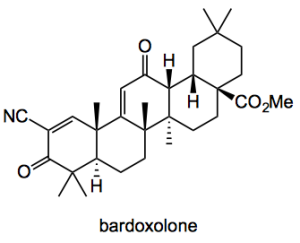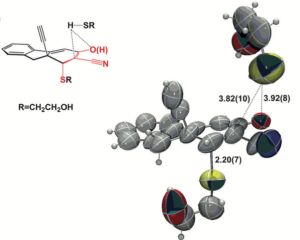In new paper Fujita shows that his “Crystalline sponges …..are applied for the first time …. for the in situ crystallographic observation of a chemical reaction”.
Yes the x-ray of a chemical reaction. In this case the conjugate addition of a thiol to a α-cyano- α,β-unsaturated carbonyl system. “This reaction has been postulated to be the mechanism-of-action for a new family of bioactive molecules containing non-enolizable cyanoenones. These molecules demonstrate unique biological features by selectively targeting protein cysteine residues in a reversible covalent fashion, avoiding off-target drug interactions. Owing to the reversible nature of the reaction, toxicity issues commonly associated with covalent protein modifications can be minimized.”
The drug in question is bardoxolone and a follow-up compound MCE-23, which was used in this study of the reaction. They lead to the suppression of cancer and inflammation.
The reaction studied:-
The x-ray examination of this reaction turned out to be complex and lots of optimisation experiments were required and even then the data was very variable. So Fujita turned to “high throughput screening for the Michael addition process. The inclusion in the sponge was thus reproduced with 65 different sponge crystals. After guest inclusion, all of the crystals were transferred to small glass vials and, for each crystal, 20 mL of cyclohexane and 2 mg of 2-mercaptoethanol (4; 2 mL of a 1 mgmL 1 solution in CH2Cl2) were added. The vials were then capped with a screw cap with the lid pierced by a needle and kept at 4 8C for 5 days. Shortly afterwards, the 65 sets of crystals were tested for their X-ray diffraction qualities with an X-ray scanner for high-throughput screening.” And here it is!
The x-ray data shows that 2 thiol molecules are involved in the reaction (which only formed 1 diastereoisomer) and a mechanistic rational is proposed.
So “… the present research expands the potential ability of the crystalline sponge to act as a molecular flask in which pseudo-solution-state reactions are performed and with which snapshots of the reaction can be obtained by X-ray crystallography. The pre-installment of reaction sites on the host framework, which was necessary in previous examples of X-ray reaction tracing in porous complexes, is unnecessary in the present study. The chemical reaction can be performed simply by treating the crystalline sponge first with a substrate followed by a reagent of interest.”
Once again a convincing demonstration and a further refinement of this wonderful methodology has been presented.
High throughput x-ray screening, just have a look at the supplementary material!
2,764 total views, no views today




